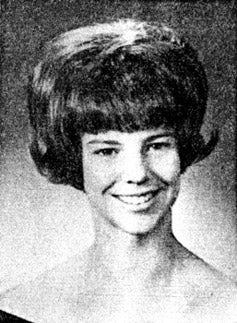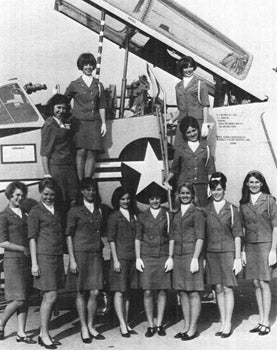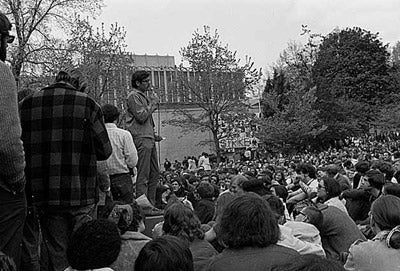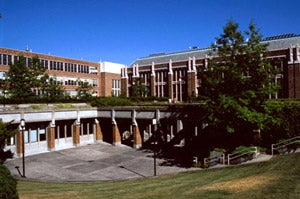The Indomitable Spirit
 Bonnie J. Dunbar, the graduate, poses for her senior portrait in 1967. Sunnyside High School yearbook photo.
Bonnie J. Dunbar, the graduate, poses for her senior portrait in 1967. Sunnyside High School yearbook photo.
 The Reserve Officers' Training Corps (ROTC) is not yet accepting women. Dunbar joins the Air Force ROTC Auxiliary, Angel Flight, shown here on a visit to Paine Field. University of Washington, 1969, Tyee Yearbook, pg. 31.
The Reserve Officers' Training Corps (ROTC) is not yet accepting women. Dunbar joins the Air Force ROTC Auxiliary, Angel Flight, shown here on a visit to Paine Field. University of Washington, 1969, Tyee Yearbook, pg. 31.
And with hard work and resiliency, that's exactly what she did.
Diploma in hand, Sunnyside High School graduate Bonnie Dunbar bid farewell to Outlook
in 1967. Showing early signs of boundless enthusiasm and chutzpah, she mailed an
application to the National Aeronautics and Space Administration (NASA), hoping
to make a quantum leap into the U.S. Astronaut Corps. Someone at the giant space
agency may have smiled, but no one dashed her dreams, she recalls. She received
a polite, encouraging response explaining the necessary credentials.
So Bonnie Dunbar prepared for college in the post-Sputnik world of the 1960s. The
Space Race was on between the United States and the Soviet Union. And America strived
to beat the Russians. A key initiative to meet the challenge was the 1958 National
Defense Education Act (NDEA). It was the ticket to the budding astronaut's dreams.
"If it hadn't have been for the National Defense Education Act (NDEA) that provided
scholarships and grant money to students willing to study science and engineering
and teachers willing to teach the subjects, I wouldn't be sitting here. I was working
in the field. I was packing corn for ten cents an ear and sorting asparagus for
minimum wage, or working in the Sears Home Repair Office as a clerk. I might still
be sitting there if I hadn't had the financial aid."
 Students gather for an anti-war rally at the University of Washington campus in 1970. Seattle Post-Intelligencer Collection, MOHAI.
Students gather for an anti-war rally at the University of Washington campus in 1970. Seattle Post-Intelligencer Collection, MOHAI.
In 1967, Dunbar pounded the pavement as one of the University of Washington's freshman
Huskies and the first member of her family to go to college. She was coming of age
and had her sights set on engineering. At the end of her freshman year, Dunbar selected
ceramic engineering. (Editor's Note: Ceramic engineering today is a multi-billion
dollar industry that uses inorganic materials and heat to make everything from snowboards,
to airplanes, to the thermal protection on Space Shuttles.)
Of course, the free spirits of the hippie era surrounded her. It was the 1960s.
The Doors topped the charts with cryptic lyrics and a cult following. Raucous protests
and marijuana found their way onto many college campuses, including the University
of Washington. Dunbar, disinterested, kept her nose to the grindstone. Looking back,
she's grateful for gifts of a strong work ethic and a sense of purpose that kept
her focused.
Following in his father's footsteps, Bonnie's brother Bobby had gone off to war,
proudly serving his country. In the spring of 1970, he died on the battlefield in
Vietnam.
"He stepped on a land mine," says Dunbar. "Crawled out and refused to have anybody
come help him because he didn’t want to put the rest of his squad at risk. For that,
he received the bronze star."
Dunbar is understandably private about the family hardship and sorrow. Tragically,
her other brother Gary died 16 years later in a house fire caused by an electrical
problem.
We came in peace for all mankind
 President Kennedy, at Rice Stadium in
1962, prepares the nation for the lunar landing. “It doesn't happen accidentally,”
says Dunbar of the country's bold initiative. NASA photo.
President Kennedy, at Rice Stadium in
1962, prepares the nation for the lunar landing. “It doesn't happen accidentally,”
says Dunbar of the country's bold initiative. NASA photo.
Whether it sealed her fate as an astronaut, Dunbar isn't entirely sure. But there's
nothing like putting a man on the Moon to whet the appetite of aspiring astronauts
the world over.
At Rice University Stadium in Houston, a young and charismatic president awakened
the American spirit.
"We choose to go to the Moon," President John F. Kennedy told a Texas crowd in September
of 1962. "We choose to go to the Moon in this decade and do the other things, not
because they are easy, but because they are hard."
Nearly seven years after Kennedy's stirring words, Apollo 11 roared into orbit atop
the massive Saturn 5, the most powerful rocket ever made. Apollo pushed across more
than 238,000 miles (383,023 km) to a prize of unprecedented proportions. At unfathomable
speeds, Apollo neared the Moon and the greatest achievement in space of all time.
While astronaut Michael Collins orbited above, Neil Armstrong and Edwin "Buzz" Aldrin
gingerly approached the dark zones and rugged highlands of the Moon's surface.
"The Eagle has landed," Armstrong reported back to Earth at 4:18 pm EDT 40 years
ago. Hours later, Armstrong descended from the Eagle.
Dunbar, a college student at the time, watched in fascination as Armstrong stepped
from the ladder and onto the Moon's powdery surface, famously declaring, "That's
one small step for (a) man, one giant leap for mankind." "It was exciting," Dunbar
says of the Moon walking. "It meant that we were really there." (Editor's note: People
debate whether Armstrong mistakenly omitted "a" or spoke so quickly the "a" was
inaudible.)
As Earth orbited the Sun above them, Armstrong and Aldrin positioned an American
flag far from home. "Here men from the planet Earth first set foot upon the Moon
July 1969, A.D.," the accompanying plaque read. "We came in peace for all mankind."
"When we went to the Moon 40 years ago, the whole world watched," recalls Dunbar.
"We should be proud that we invested so much into education, technology, and the
industries we have today. It has benefited our society and improved our quality
of life. We should never underestimate the role that science and technology has
had in every major civilization since the dawn of time."
 Mueller Hall, constructed in the 1980s, is named for James I. Mueller, a faculty member at the University of Washington from 1949 - 1973. Mueller, Chair of the Mining, Metallurgical, and Ceramic Engineering Department, encouraged Dunbar to dream big.
University of Washington photo.
Mueller Hall, constructed in the 1980s, is named for James I. Mueller, a faculty member at the University of Washington from 1949 - 1973. Mueller, Chair of the Mining, Metallurgical, and Ceramic Engineering Department, encouraged Dunbar to dream big.
University of Washington photo.
Building the Dream
Still inspired by one of the great stories of the 20th Century, Bonnie Dunbar was
a young woman dreaming of space and in doing so, well ahead of her time. To a few
of her college professors, Dunbar's aspirations seemed bold and unrealistic. It
was "not a field for women," they told her.
Dunbar could not be dissuaded. For every professor who doubted her, she says gratefully,
many more boosted her up – giving her a work ethic, a sense of purpose, and the
ability to see dreams within reach. Besides, as the eternal optimist, Dunbar ignores
the cynics anyway. "If you let them take up your brain space you're wasting it,"
she says adamantly.
A strong source of encouragement was Dr. James I. Mueller, an affable University
of Washington professor and Chair of the Department of Ceramic Engineering. Professor
Mueller never seemed to mind the end-of-the-year pranks orchestrated by graduating
seniors. In fact, Dunbar suspects the longtime professor enjoyed the pranks. He
never got angry, she says smiling. His students were his great passion.
"When I told him my freshman year that I really wanted to become involved with NASA
and be an astronaut he didn't laugh, he didn't try and dissuade me. He just promised
that I would be able to meet NASA engineers if I joined his department. After that,
he was true to his word."
Luckily, the professor was Principal Investigator on a special research project
funded by NASA. Dr. Mueller, Dunbar and a University team developed the materials
for ceramic tiles that shield Space Shuttles as they reenter the Earth's atmosphere
and encounter 2300-degree (1260°C) heat.
The late Mueller, who lost his battle with cancer at 69, may have been one reason
Dunbar became a mentor herself. She's hosted barbeques with engineering students
and helped launch space school programs in Scotland, Wales, and the U.S.